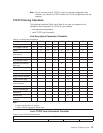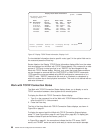Ending TCP/IP Interfaces
The ENDTCPIFC (End TCP/IP Interface) command ends an existing TCP/IP
interface immediately. As a result, all TCP/IP connections using this interface also
end immediately. However, the operation of any other TCP or IP over SNA
interface, using the same line description as the interface that is ending, is not
affected.
TCP/IP interfaces can be ended in one of two ways:
v Using the Work with TCP/IP Interface Status display, which is reached by:
– Option 1 on the Configure TCP/IP (CFGTCP) menu
– Option 1 on the Network Status (NETSTAT or WRKTCPSTS) menu
v Using the ENDTCPIFC (End TCP/IP Interface) command
To end a TCP/IP interface from the Work with TCP/IP Interface Status menu:
1. Type 10 in the option field for each interface that you want to end.
2. Press the Enter key.
To end a TCP/IP interface using the ENDTCPIFC command:
1. Type ENDTCPIFC on the command line.
2. Press F4 (Prompt).
3. Type the Internet address of the interface that you want to end.
4. Press the Enter key.
Option 10 on the Work with TCP/IP Interface Status display is used to end both
TCP/IP interfaces and IP over SNA interfaces. For information about ending IP over
SNA interfaces, see the ENDIPSIFC (End IP over SNA Interface) command in the
CL Reference (Abridged)
, SC41-5722-03.
Route-to-Interface Binding:
Interfaces define direct paths to networks or
subnetworks to which an AS/400 system is directly attached. Routes define indirect
paths. A route identifies the first hop on the path to a network or subnetwork to
which an AS/400 system is not directly attached.
Routes are bound to interfaces through the use of a best-match-first algorithm. This
algorithm is based on the state of the interface, and on the type of service (TOS)
specified for the route and interface. When you end an interface, the routes
associated with the interface can move to another existing active interface if the
following conditions are satisfied:
v If the TOS for the route is something other than *NORMAL, the algorithm looks
for an interface with the same TOS. If an interface with the specified TOS is not
found, an interface with TOS *NORMAL is sought. Again, if one is not found, that
route will not be moved.
v The MTU value for the route that is being moved must be less than or equal to
the MTU value for the active interface.
v The network ID of the interface must be equal to the logical AND of the next hop
for the route and the subnet mask for the interface.
Notes:
1. If the next hop of a route is identical to an interface’s IP address, that route will
never be bound to another interface.
2. When starting interfaces (if all interfaces are currently inactive) routes are bound
to the interfaces with the same best-match-first algorithm. An exception is if the
58 OS/400 TCP/IP Configuration and Reference V4R4


















